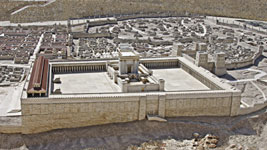No, the title is not a slogan from the feminist movement but an important statement in our journey of exploration through Acts chapters 3-5. In chapter 3 Peter and John had healed the lame man in the Name of Jesus, who immediately was “walking and leaping and praising God.” This caused quite a stir in the temple, as the lame beggar was well-known to the regular worshippers. When the crowd “were filled with wonder and amazement at what had happened to him” (verse 10), Peter took the opportunity to declare that the man had been healed “by faith in his A model of the Jewish temple in the time of the book of Acts (Dmitry) “And as they were speaking to the people, the priests and the captain of the temple and the Sadducees came upon them, greatly annoyed because they were teaching the people and proclaiming in Jesus the resurrection from the dead” (Acts 4:1-2). The Sadducees were a sect within the Jewish faith who were anti-supernatural and did not believe in miraculous events like resurrections. That is why they were “sad, you see!” So they jailed Peter and John for the night as the court only met in the morning, but 5,000 men “who had heard the word believed” (Acts 4:4). Most preachers today would give anything for results like that! Peter and John were given a top-level audience the next morning, 70 leaders of the Jewish faith were in attendance. “They inquired, By what power or by what name did you do this?” (verse 7). So there was no denial or question of the healing but rather of the “how.” Peter, who had denied any association with Jesus just weeks before, was now a changed man. Stand him up and he’d preach anywhere! So he laid into the Sanhedrin, the 70, who had insisted the Romans crucify Jesus, “whom God raised from the dead — by him this man is standing before you well” (verse 10). Since the once lame man was standing beside Peter and John (verse 14), Peter’s words were along the line of “Now what have YOU got to say about your unbelief?” And then the salvation appeal to 70 religious leaders, “And there is salvation in no one else, for there is no other name under heaven given among men by which we must be saved” (verse 12). In other words, “And YOU need to get saved also!” Don’t you just love it? This is what pastors call “preaching to the choir.” Just as I like the familiar yet old-worldly flow of the King James Version in Acts 3:6, “Such as I have give I thee,” I love the KJV translation of Acts 4:13, “Now when they saw the boldness of Peter and John, and perceived that they were unlearned and ignorant men, they marveled; and they took knowledge of them, that they had been with Jesus.” What a testimony from the opposition! Oh how we need men like that today! The 70 leaders were all university or seminary graduates of their day, yet here were the despised country bumpkins from Galilee doing what the leaders could not do. “Unlearned” means uninstructed in the professional rabbinical schools, just as Jesus was regarded, “How is it that this man has learning, when he has never studied?” (John 7:15). “Ignorant” is from the Greek word “idiot” which English borrowed, and really means “one who has nothing but his idiosyncracy” (Robertson’s Word Pictures), but it was used of the common person in the street, the “hoi polloi,” a lay person. They just didn’t move in the same circles as rabbis, much the same as most healing evangelists since the early 1900s never studied to be ministers but just followed the calling of God on their lives. “They recognized that they had been with Jesus.” This is obviously literal, in that someone in the Sanhedrin had seen Peter and John in the company of Jesus. The overturning of the money-changers’ tables and the preaching of Jesus in the temple area would make it obvious that the authorities were keeping watch on Jesus and the band of disciples. However, there seems to be more in the statement that concerns their confidence and their actions. “Their whole being identified them with Jesus. ‘We thought we had got rid of Him; but lo! He reappears in these men, and all that troubled us in the Nazarene Himself has yet to be put down in these His disciples.’ What a testimony to these primitive witnesses! Would that the same could be said of their successors!” (Jamieson, Fausset and Brown). So instead of the human Jesus, the leaders had two men with Christ in them standing before them and another 8,000 in the city of Jerusalem, all with Christ in them. “But we impart a secret and hidden wisdom of God… None of the rulers of this age understood this, for if they had, they would not have crucified the Lord of glory” (I Corinthians 2:7a,8). Now the religious leaders have a problem! “But seeing the man who was healed standing beside them, they had nothing to say in opposition” (Acts 4:14).
Ignorant and unlearned men
[Jesus’] Name.”
While Peter made the point that the Jewish people had cried out for Jesus to be crucified, he went straight on to proclaim the resurrection of Christ from the dead (Acts 3:15). The resurrection became the predominant message of good news given by the early church, and this is what caused the problem with the religious leaders of the day. Apart from this incident, there is very little in the book of Acts of “the message of the Cross,” as some term the death of Jesus. However, “with great power the apostles were giving their testimony to the resurrection of the Lord Jesus, and great grace was upon them all” (Acts 4:33). Everyone dies, but there have only been a few resurrections, and apart from Jesus those resurrected later died again.



Leave A Comment